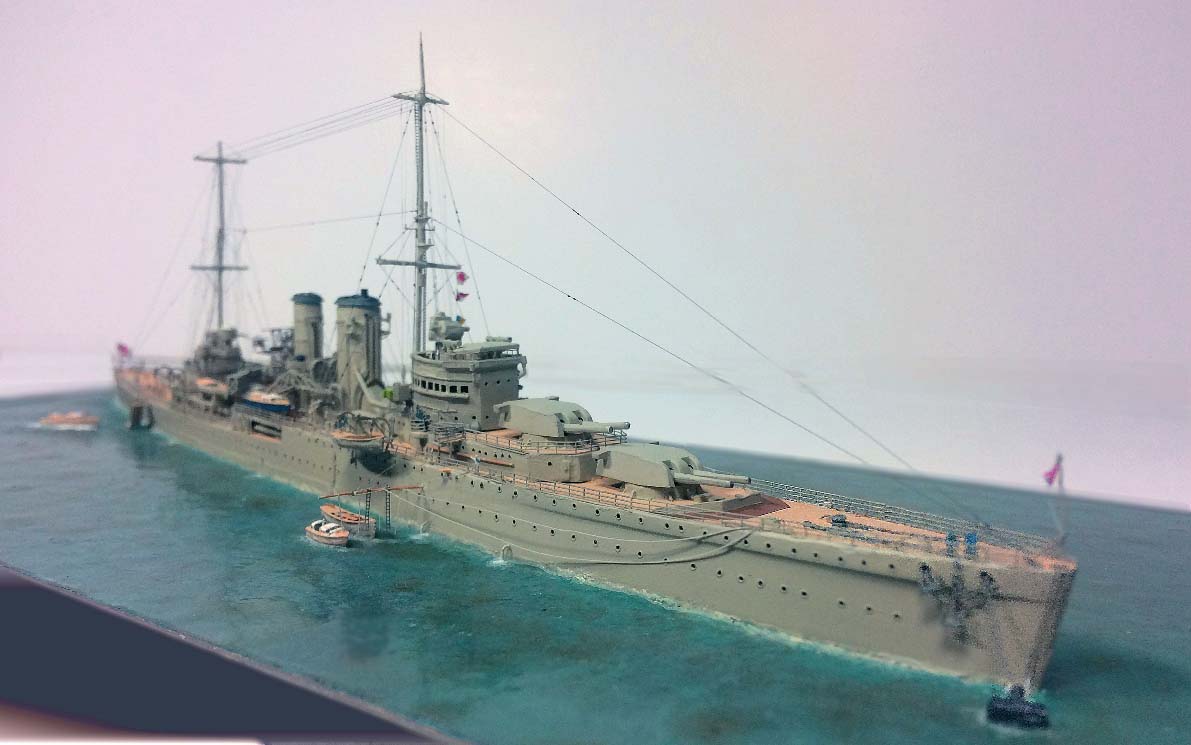
1/700 HMS Exeter (Matchbox)
|
by Chris Smithers |

1/700 HMS Exeter (Matchbox)
Although the Matchbox kit is quite elderly, in its day it was stunning compared with what Airfix were offering then. And it still manages to hold its own today. I picked this one up on eBay.I used two sets of the WEM HMS Sussex PE set because I needed two catapults (cut to length) and a lot of boat davits and railing. The aircraft/boat crane had to be narrowed to fit, and the accommodation ladders halved in height. 4-inch guns are from Niko and the 0.5 inch MGs from the WEM ‘Ultimate Destroyer/Cruiser set ‘ (technically over scale at 1/600 but too small to notice). The ship’s boats are from L’Arsenal with PE boat fittings from WEM. I’d also got the WEM resin ship’s boats but was very disappointed in them – they did not scale well dimensionally and were rather crude. The injection-moulded boats in the Matchbox kit were actually better (apart from the whalers and dinghy). The Walrus amphibian was also from L’Arsenal with Starfighter decals from Marks Models and Toys.
Masts and yards are soldered brass and embedded in the hull plate for rigidity. The rigging is all in Caenis thread but the standing rigging is more than just superficial decoration – it actually performs a structural function in holding the masts rigid against the tension of the wireless aerials strung between the mast yard arms. The fore and aft dressing lines also helped here. I’ve learnt from hard experience how Caenis thread used for wireless aerials can exert an incredible tension on masts, bending them like bananas. Paints are Colourcoats from Sovereign Hobbies and need no comment.
My painting technique in the past has been to airbrush the hull first and then hand-paint the decks. However, I was unhappy with the lumpiness of the paint on the decks of my previous efforts, even with the paint well thinned and applied in layers. This time I reversed the sequence, airbrushing the decks first, then masked them off (not as tricky and fiddly as I’d feared) and airbrushed the grey hull. It gave a very satisfactory result. I shall use the approach in future, bearing in mind however any complexity in the superstructure that might rule this out.
I’m not claiming this is a perfect build, far from it. Amongst other things I had an awful time with the funnel bands and guys, especially after they broke and had to be refitted.
I was amazed how cramped and congested the ship was around the after funnel, squeezing in a Carley float, boat crane and motor boat. And then aft of that the crane cab, catapult foundation and pulling launch. There was then hardly enough space for the whaler, so I decided to have the davits swung out. I’ve seen photos and drawings where the whaler’s bow is actually inboard of and overlaps the stern of the launch ahead of it.
In a moment of insanity I felt it might be possible to rig the sailing dinghies with main and jib sheets. To my surprise, with the finest of fine stretched sprue it was, so I did a similar thing on the two-masted gig. Like the standing rigging on the ship, these also had a function in trimming the sails correctly. One dinghy is on a close reach to windward with the crew hiking out to balance it, and the other goose-winged running before the wind.
Thanks to the excellence of the basic Matchbox kit, I feel the model captures the character of this rather handsome ship (so much better looking than her ugly step-sister HMS York). So here she is, moored to a buoy somewhere in the Caribbean in the mid-1930s, her crew enjoying some recreational sailing in the deep, calm blue waters.
My thanks to Mike McCabe for the various drawings and sketches he emailed me a number of years ago in preparation for this project, Jim Baumann for Walrus aircraft decal source, and David Griffiths for inspiration and techniques.
I used a great deal of detailed information about ship’s fittings, boats and boat handling equipment found in the book ‘The Life and Ship Models of Norman Ough’ and in ‘Scale Model Warships’ edited by John Bowen, published in 1978. Other references were ‘British Cruisers of World War Two’ by Raven and Roberts, ‘British Cruisers’ by Friedman, Warships Profile 13, and last but very far from least the 1/400 scale JSC cut out card kit No.403.
